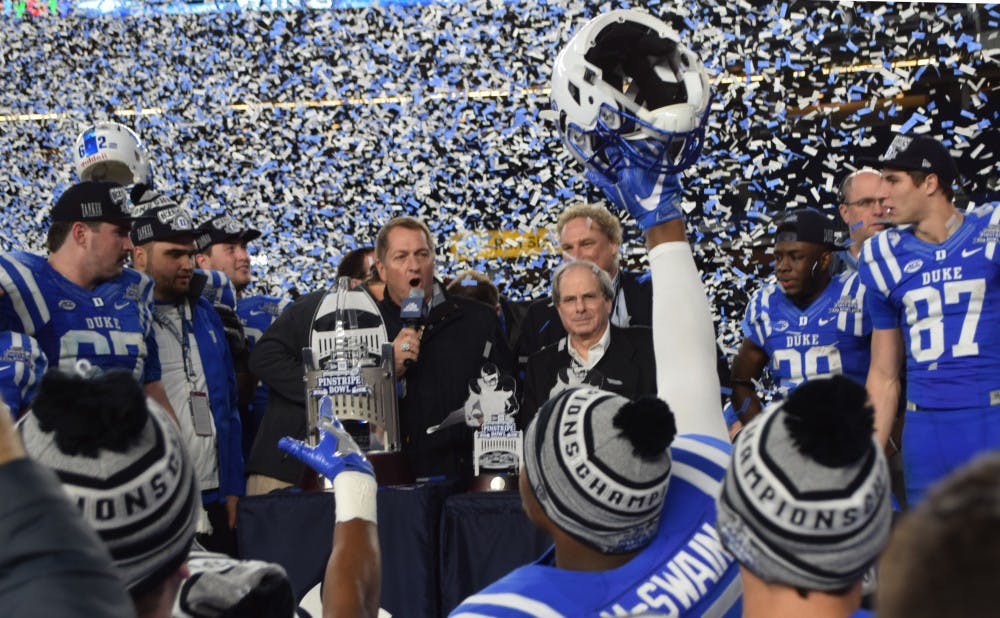NEW YORK—In its last three bowl appearances, Duke has been known to step outside of its basic offense, displaying a little trickery in search of a taste of the bowl success that had evaded the program for so long.
In last year's Sun Bowl, Will Monday found a wide-open Johnell Barnes on a fake punt. Later, wide receiver Jamison Crowder threw a two-point conversion with his left hand on a jet sweep to give Duke a brief lead against Arizona State.
Leading up to the New Era Pinstripe Bowl, after it was announced Dec. 13 that offensive coordinator Scottie Montgomery would take over the head coaching vacancy at East Carolina next season, questions swirled around how tricky the offensive mastermind might get in his last outing with the Blue Devils.
“Scottie, might he throw the ball deep every play? That we’ll find out,” Duke head coach David Cutcliffe said in a press conference Dec. 17.
Once in New York, Montgomery attempted to downplay the trickery, saying that the Blue Devils' approach would be "basic. There’s going to be no trick plays, none of that kind of stuff."
But come game time, Duke was anything but basic. The Blue Devils nearly pulled off a fake punt, attempted a first quarter onside kick, allowed running back Shaun Wilson to throw the ball and broke out a new wildcat formation without quarterback Thomas Sirk under center.
Unfortunately for the Blue Devils, rarely did the trickery pay off against Indiana, no matter how well executed a play seemed.
When Monday came on the field with just less than 3:30 remaining in the second quarter facing a fourth and two at the Hoosier 47-yard line, all signs pointed to the All-American punter booting the ball away with the score 10-7 in favor of the Blue Devils. But Monday took the snap, feigned a rugby style punt to his right and turned back to his left where a wide-open Braxton Deaver was waiting beyond the first down marker.
The ball spiraled through the air, but floated just long enough for Indiana cornerback Ben Bach to collapse coverage on Deaver and prevent the catch.
“We were just short on the Monday pass,” Montgomery said. “We really worked that one hard.”
Earlier in the contest, Wilson had broken through the defensive front and scampered down the field for an 85-yard touchdown. Although it was the first quarter and the Blue Devils had a 10-0 lead at the time, the call came in for an onside kick.
Senior Ross Martin lined up to send the ball deep, but at the last second, squibbed the ball down the right sideline. The ball bounced off the Yankee Stadium grass and into the arms of the Hoosiers’ Andre Booker at the Indiana 45-yard line, gifting quarterback Nate Sudfeld excellent field position.
A similar play worked to perfection in the 2013 Chick-fil-A Bowl against Texas A&M, when the Blue Devils opted for an onside kick with just more than 2:30 left in the first half. Duke may have been up 35-17 at the time, but the kick yielded three more points heading into the locker room.
Although Sirk assured reporters leading up to the bowl game that the Blue Devils would remain within their game plan, it seemed that Montgomery had other ideas in his final game behind the call sheet. Duke attempted several new Wildcat packages with direct snaps to running backs and Wilson lobbed a ball downfield on a run fake in the fourth quarter with the score knotted at 34—but the throw fell straight into the arms of Indiana safety Jonathan Crawford at the Indiana 15-yard line.
“If you got to watch us [in practice], there are certain things that we saw during four weeks of preparation where you think that you can hit guys,” Montgomery said. “Shaun’s throw—all week he worked his butt off to where if that safety was down he was going to throw it, if the safety was high he was going to run it. With all of that emotion running into it, we just didn’t make the correct throw there.”
The trickery may not have produced positive results, but the Blue Devils delivered enough explosive plays on regular play-calls to eek out a 44-41 overtime victory. For the first time in four tries, Duke made the plays in the fourth quarter—and in the extra session—that had haunted the program in its last three bowl defeats.
“That’s who we are. These guys haven’t played in a bowl game before we got here for so long, and we get to a chance and time to win a bowl game [for the first time since] 1961, we’re going to do everything we possibly can do to win that game,” Montgomery said. “I love the way Coach [Cutcliffe] did what he did in all the situations tonight because we were not coming here to tie, or to go home happy about scoring points or stopping them…. We wanted to win the game.”
Duke had an opportunity to do so in regulation. After Sirk plowed in from five yards out to cut Indiana's lead to 41-40, the Blue Devils could have chosen to go for the two-point conversion.
With the game on the line, they almost did.
“Yes, there was [a thought of going for the two-point conversion],” Montgomery said with a laugh. “Those things always come up. In the end, we made the right decision.”
Get The Chronicle straight to your inbox
Signup for our weekly newsletter. Cancel at any time.

